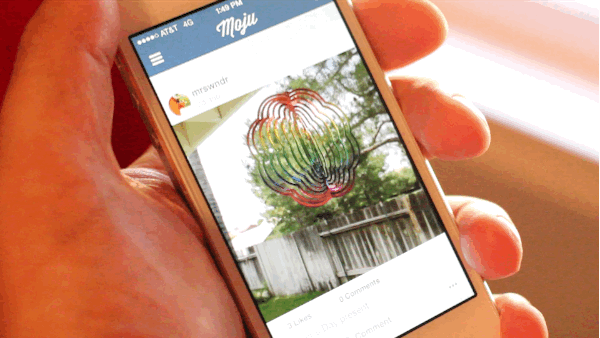As our phones become more camera than phone, it only makes sense that innovators would try to take on the very 20th-century concept of the “photograph.”
We’ve thus far seen a slew of apps using tech unique to our mobile devices, utilizing video and sound recording, sensors, GPS and the phone’s accelerometer to transform how users create and share images.
Apps like Seene, Mindie, Frontback, Vine and even Instagram itself now compete to be your mobile go-to for what my co-editor Matthew Panzarino calls “vertical streams of cool, clever things.” Moju, an app that leverages the iPhone’s ability to capture a series of photos and user movements, is today adding its name to the game. It aspires to be a concise, hyperreal alternative to the pitfalls of video on mobile.
The formula to win the “beyond photos” game is innovation in grades, where an extra second or two shaved off, or the right shade of filter, means the difference between hundreds of millions of users and dollars or a slow fade into the Amaro-hued sunset.
Drawings of fire-breathing dragons roasting chickens with their breath and creative time-lapses of boiling rice are some of the most compelling Mojus drawing inspiration off the app’s constraints.
Like many of the “beyond photosharing” apps, Moju picks and chooses what’s valuable to highlight — there is no audio, which means less load time for the 24 frames it allows you to capture. From a consumption standpoint, it — like Seene — also plays into our innate human attraction to 3D dynamics, tying the iPhone’s motion-sensor movements into what we see onscreen, the shared images moving as viewers twist their phones from left to right.
“Right now, we’ve simplified many things,” founder Mok Oh writes. “For example, the ‘simply twist’ motion only reads when users pivot the camera left and right. We’ll map up and down motion to something else later (it’s a surprise).”
While the success of every new mobile and video-sharing app is a big “we’ll see,” there is already evidence of Vine-like “stories” being told on the Moju: Drawings of fire-breathing dragons roasting chickens with their breath and creative time-lapses of boiling rice are some of the most compelling Mojus drawing inspiration off the app’s constraints.
Like Vine, it’s up to the community, and the product’s ability to riff on those constraints, to create the memes that usually fuel the growth of these types of social apps.
Moju Labs has raised $1 million from Googler Eugene Jhong and the infamous Eduardo Saverin and his brother Alex Saverin. The company plans to use the money to build more personalization, relevance and automation into the existing mobile product, which is now available in the App Store.
A former art student, MIT graduate and PayPal scientist, Mok Oh thinks that Mojus, as he calls them, have the potential to be the new form of media. “I think what we have is a new content type that is much more expressive than photos and much simpler than videos,” he says. “And still, it is very much ‘compatible’ with both.
“Photos are often too concise — limited to a slice in time,” he elaborates. “With Moju, we expand capturing beyond a slice and add that time dimension. Videos are often not concise enough — a minute video is 50 seconds too long these days. It’s a simple idea, but simple ideas are often the most elegant.”
